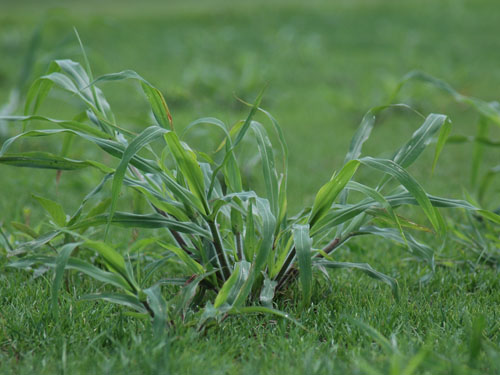Weeds can tell you a lot about the condition of your lawn and understanding weeds for what they indicate about your lawn care practices and soil conditions is actually very simple. Simply put, weeds thrive in soil that is compacted, not pH balanced, and in lawns that are improperly mowed, watered or are thin with bare spots and in need of seeding. Below are the most common cultural practices, turf conditions, and soil attributes that can contribute to weed issues and by following you can eliminate the conditions that promote weeds.
Cultural Practices
Mowing Height – Poor mowing practices cause many lawn issues. Mowing lower than 1.75 inches can kill the root system by preventing photosynthesis, and mowing with a dull mower blade makes your lawn susceptible to disease. A low mowing height also allows sunlight in for weeds to germinate.
Most lawns in our local area are a mix of Tall Fescue and Kentucky Bluegrass seed varieties. Generally, you should keep a lawn mowed at 3-3½ inches. Mowing high allows the grass to develop deeper, drought-resistant root systems. Do not mow more than 1/3 of the grass blade at a time. Keep your mower blades sharp, mower blades should be sharpened every 8-10 hours of actual cutting time. Grass clipping contain 58% of the nitrogen added from fertilizers, the clippings also improve soil conditions, suppress disease, and reduce thatch and crabgrass. So, do not collect clippings.
Watering – Drought conditions, excessive watering or poor drainage, are all invitations for weeds. Watering needs are very site specific, but generally a deep watering of 1 inch per week and up to 2 inches in the summer months once a week is the best. Also, watering in the morning is preferred to eliminate evaporation and prevent lawn diseases for establishing.
Turf Conditions
Compaction – Compacted soil is an invitation for weeds. If your lawn is hard, compacted, and full of weeds an annual aeration will help air, water and fertilizer to enter, along with relieving compaction. If you can’t stick a screwdriver easily 6 to 8 inches into your soil, it’s too compacted.
Thin turf / bare spots – As your lawn becomes thick or dense, it will naturally choke out weeds. Consider overseeding your entire lawn if your lawn is not at least 80% thick or slit seeding if there are significant bare spots that need to be filled in.
Thatch – This is the dense layer of grass stems and roots on the surface of the soil. When thatch layers become ½ inch or more, the roots will grow up within the thatch instead of the soil, making grass susceptible to insects, disease, and weather stress. A thick layer of thatch will also prevent water from going down into the soil by creating a thick blanket where water will just run off and not penetrate down below. Thatch is reduced by aeration or dethatching using a power rake. Contrary to many beliefs, recent research has proven grass clippings do not contribute to thatch buildup.
Grass seed – Grass varieties differ enormously in their quality, appearance, resistance to pests, diseases and acceptance to weather conditions. Weeds can easily become established in a lawn as a result of using poor quality grass seed blends.
Soil Attributes
Soil testing will determine pH, available nutrients and organic matter percentage, all of which need to be properly balanced for optimum turf conditions and prevention of weeds. The pH scale is from 0 – 14 with 7.0 being neutral. Below 7.0 is considered acidic and above is considered alkaline conditions. Ideal pH should be slightly acidic between 6.5-6.8 for the most optimum lawn conditions.
To raise or lower the pH level, a soil test is required to determine necessary amounts of additives such as limestone or sulfur. Adding compost will also change the pH level and is recommended for soil conditions when the pH level is highly buffered or if the organic matter % is below 4%. Turf grasses in our local area require a combination of 16 different nutrients for the optimal growth. Proper balances of these nutrients are required to combat weeds. Lawns with pH issues, excessive amounts or deficient amounts of nutrients and low organic matter % will always have weed issues.

